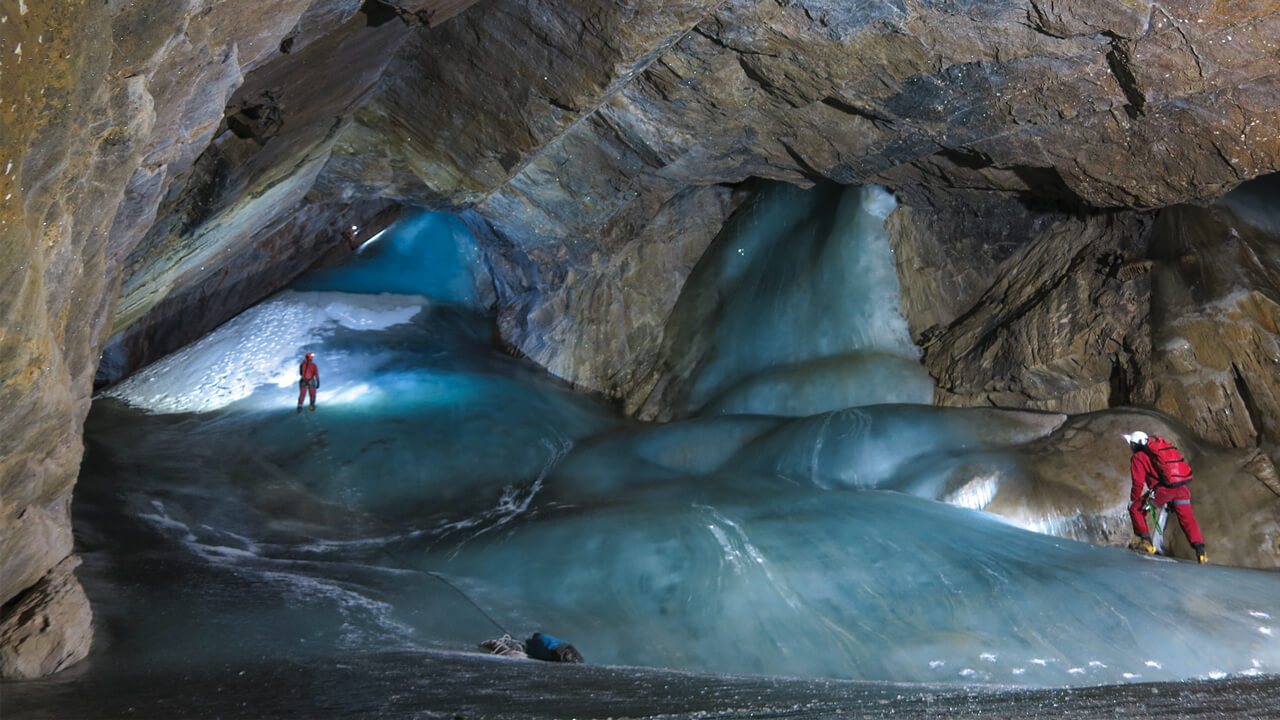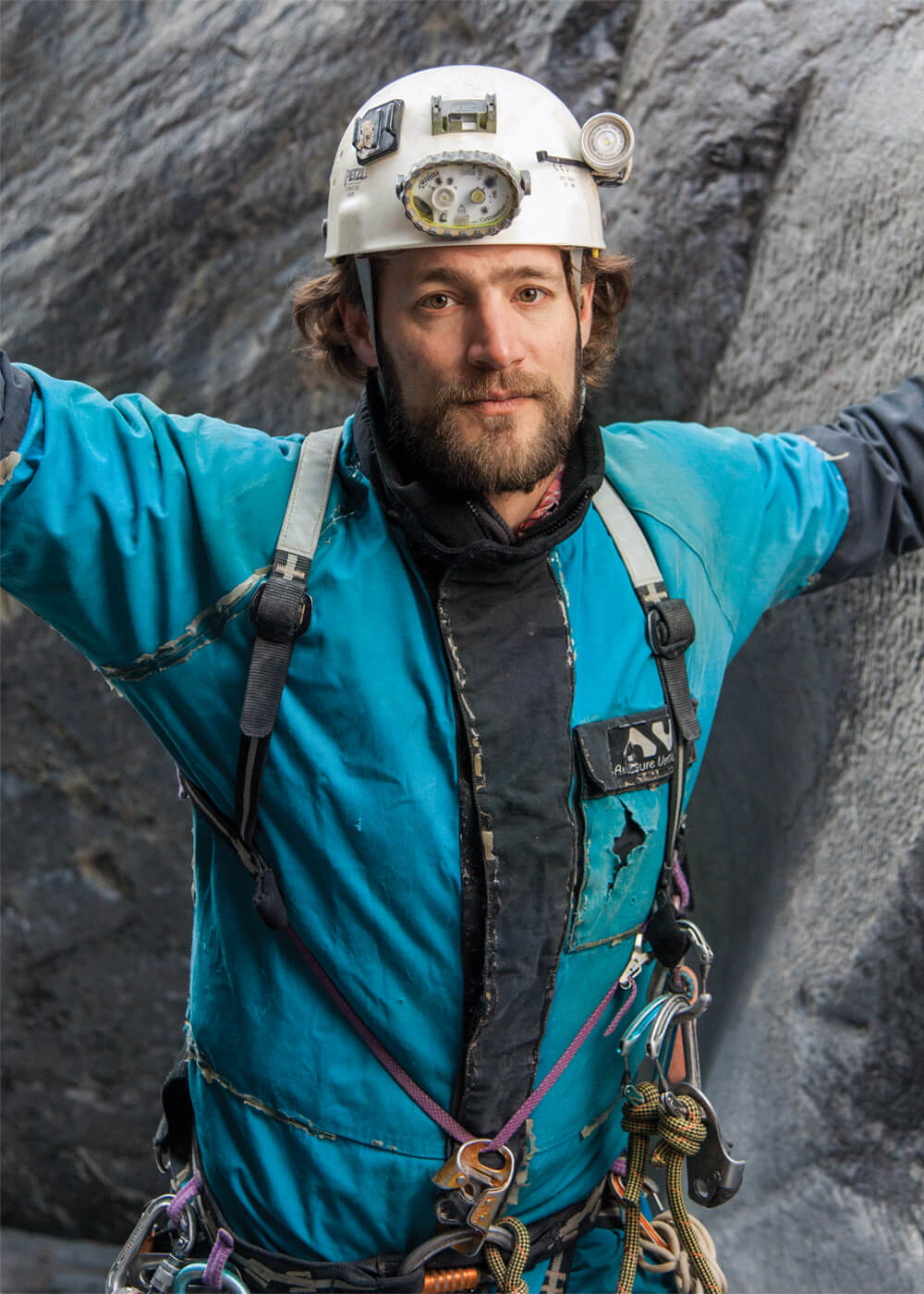It’s easy to imagine the cave before Nick Vieira: darkness like a pillow over your face, the smell of wet sand, the white roar of rushing water. Before Nick Vieira, there are no passageways like subway tunnels, no crystalline rock formations, no murderous drops, no life-threatening climbs. Before Nick Vieira, the map is a blank page, the cave is absence. But after him, it exists, a whole new world extending with every step he takes, and imagining it becomes a more demanding endeavour.

It’s Feb. 2, 2012, and Vieira has been cleared by Parks Canada to enter an active avalanche zone. He’s parked Elijah, the beat-up, sky blue Jeep Cherokee he lives in year-round, on the side of the Trans-Canada Highway and hiked 2.4 kilometres through snow and spruce, straight up the side of Mount Tupper in the area of the Canadian Rockies known as Rogers Pass. He’s entered an unmapped cave, called Raspberry Rising by the first people to attempt a proper survey, and scrambled 70 metres over rocks and shin-deep water to a point where the passage seems to dead-end, then suited up in his dive gear and continued forward the only way he can — pulling himself through the first sump, 15 metres of passage flooded floor-to-ceiling by the near-freezing flow of glacial meltwater that formed this cave in the first place. He is completely alone.
Rising up through the sump, the lamp on Vieira’s helmet lights the water from below like a swimming pool, revealing grey-and-tan walls of schist and swirling marble. His head breaks the surface and he spits out his regulator, breathing air that’s filled no lungs but his in the past two decades. The dry suit he’s wearing allows him to linger in the water without risking hypothermia, but he moves with purpose anyway, unclipping his scuba tanks and then hauling them and the rest of his gear deeper into the cave. He follows the passage in front of him around one quick corner before his light splashes over the barrier the few who visited this cave before him found insurmountable — a waterfall rising more than 20 vertical metres in three fractured segments.
Vieira free-climbs six metres up to a wide ledge where water from the falls collects in a shallow pool before spilling over the lip. Though his path takes him straight through the freezing spray, the initial leg of the climb is the easy part, with grooved handholds beaten into the marble by crashing water. Above the first ledge, the wall beside the falls is smooth schist, with few grips big enough to provide a solid hold, especially for a climber wearing dive gloves and rubber boots. Vieira instead opts to ascend directly in the path of the waterfall. The rush of water makes it impossible to see anything, even with his dive mask on, and fighting uphill against it takes incredible strength and endurance. Vieira picks his way by feel, carefully locating one hold, then the next, pausing at regular intervals to drive anchors into the rock with a hammer drill. Setting each takes only a matter of seconds but still involves clinging to the side of a slick marble cliff face with one hand, the waterfall beating down on his head and shoulders, while he drills into solid rock with the other — gruelling, teeth-chattering work.
After seven more brutal metres, Vieira pulls himself up onto a second ledge. This one is smaller, a metre and a half deep at its largest point, but it sits slightly to one side of the falls and provides some relief from the water. On that tiny patch of what passes for dry ground, Vieira reorganizes his ropes and sets another anchor. Then he presses on, up the final nine-metre climb. At its lip the waterfall is wall-to-wall — the full volume of meltwater running off the East Tupper Glacier concentrated into a single stream a metre and a half wide. The handholds here are so small that Vieira has to hang from the tips of his fingers. He sets a skyhook — a piece of metal he can attach to the wall and rest his weight on — giving his hands a break while he plans his next move. Free-climbing the last few feet is impossible: the falls would blow him off the wall. Vieira decides to use a small rope ladder, called an etrier, to give his boots a reliable leverage point. He wrestles it out of his pack, clips it to the skyhook, positions himself on it, and then drives up into the dark crush of water. The final push is ugly, an elephant seal floundering its way up the beach. Eventually, Vieira squirms belly first onto the top of the falls and rises to his feet. His first steps on ground no human foot has ever touched are a jig.
Chasing experiences like that first glorious moment atop the falls, Nick Vieira has sacrificed comfort, security, relationships, possessions, warm meals and damn near every other thing a person can wrap themselves up in and call a normal life. Any money he earns he pours into his expeditions. He’s slept in his Jeep through five Canadian winters, survived on expired army rations and caught falling rock with the top of his head. But he’s also rafted across buried lakes, mapped vast expanses of subterranean sand dunes and crawled underneath four continents. In just seven years, he’s gone from a first-time caver to one of the best in the world. A transformation like that is anything but normal.

By 10 a.m., the fog draped over the shoulders of the Rockies had pulled back to reveal the mountains rising around the city like giant cupped hands. Waiting by his Jeep in the parking lot of Canmore, Alta.’s Elevation Place — a community centre and climbing gym just in from the highway — Vieira wears a dark fleece over a short-sleeved plaid shirt and practical-looking black pants, jacketless in the unseasonable warmth.
There’s a tendency to imagine cavers as pallid human geckos, bending and contorting their way through impossibly claustrophobic cracks in the earth. Vieira disabuses one of it. Six-foot-three and a sturdy 230 pounds, he’s built like a Viking — barrel-chested and thick in the legs, with forearms like heavy wooden oars. Strong-jawed and handsome, he wears a short, sandy brown beard that’s a shade lighter than his eyes. Today — Oct. 21, 2014 — his hair is mostly hidden under a thin black toque.
Vieira has been waiting the better part of an hour for his ride back to Raspberry Rising and the start of his third season of exploration at the cave. He doesn’t do well with downtime, and he’s anxious to get on the road. When the ride finally arrives, Vieira is awkward and rushed, his greeting minimal, his brain miles ahead of his mouth and the moment. He quickly transfers his gear from his beat-up Jeep to the tiny rental car. When the trunk is filled with ropes and lights, and the pile of scuba tanks and sleeping bags in the back touches the roof, Vieira settles into the passenger seat.
That Vieira is so eager to get back to Raspberry doesn’t make much sense considering he nearly died on his last trip there, the final expedition of the 2013–14 season. Recalling the experience, he’ll admit that it was his scariest moment in a cave, but that conversation won’t come until later. Before you can understand where Vieira is and where he’s headed, you have to know where he came from. On the two-and-a-half-hour drive from Canmore to Rogers Pass, in a voice so soft you forget the size of him, he starts to fill in the blanks.
Vieira was born into what he calls a “broken home” in the northwestern B.C. interior in 1980. His father was a “hippie,” and when the marriage fell apart and his mother packed up four-year-old Nick and his two brothers and left, Dad let them go. His mom remarried. When Vieira was nine, the family moved to Wolfe Island, a short ferry ride from Kingston, Ont. in the wide, wind-chopped water of Lake Ontario. Six years of relative stability followed, ending when his mother once again packed up and left. This time she didn’t take her boys.
Cared for by his stepfather, Vieira finished high school and headed back to B.C. to reconnect with his dad. He spent a year and a half living in an unheated trailer and working the 160-acre farm his father owned, but relations between the two men slowly soured. After a failed attempt to join the military — his third — Vieira applied to a meat-packing plant in Brooks, Alta. and got the job. “A week later I got onto a bus with $50 in my pocket.” At 20, he was fully on his own.
Vieira spent the next six years killing and dismembering animals for $13 an hour. For a time he lived in a stranger’s pantry, then he bedded down on a bench in a slaughterhouse; he was stabbed 14 times — all workplace accidents — and inadvertently shot himself in the face while killing an elk. At what he considers his physical peak, Vieira could comfortably walk around with a 400-pound side of beef in his arms. It wasn’t his life’s work, but he was content — until he had the dream.
In it, he’s working on the line, the task and surroundings at once familiar and unrecognizable. Something goes wrong, bodies coming faster than they can be broken down. In the chaos it’s clear they aren’t going to ship enough meat on time. In order to make their deadline, the workers resort to butchering one another. Vieira had the dream twice. Twice was plenty. He began saving for fire college — interested in a line of work that would allow him to help living things. When he had just enough for tuition, he enrolled.
The second time school released him into the world, Vieira knew what to do with himself. He found a full-time position in industrial fire protection and standby rescue with a company called Firemaster in Red Deer, Alta. He worked hard and efficiently and was eventually offered a position training emergency-services personnel. He taught alongside a “rope and confined spaces guru” and former civil engineer named George Hanus, passing on techniques that could, for example, allow a first responder to reach a heart-attack victim trapped on top of a cooling tower. Hanus recommended Vieira pick up a hobby to maintain his professional skills now that he was no longer in the field. He offered to take Vieira caving.

In the car, telling his story, Vieira doesn’t make much of his first trip underground with Hanus. “We didn’t really go anywhere special,” he says. Hanus took him to Rat’s Nest Cave, a tourist-friendly historic site near Canmore. Hanus, Vieira and a couple of friends from the fire department covered the stretch of the cave “where the tours tend to go,” and then pushed deeper. They were still in well-trod territory, but simply moving through the cave placed demands on Vieira’s professional skill set that no other environment had. It was the most challenging and fulfilling activity he’d ever tried. “I was definitely hooked,” he says.
In 2008, less than a year after first visiting Rat’s Nest, Vieira gave four months’ notice that he was quitting his day job. He spent the following winter working as a dogsled guide and then, in the summer of 2009, packed his possessions into his Jeep and drove to Vancouver Island where he got a job as a cave guide at Horne Lake Provincial Park. He lived in a tent and “got paid dirt,” but he spent most days underground.
Vieira was promoted the following summer, but by the end of his second season he was a couple of thousand dollars in debt and couldn’t see a future guiding on the island. “When you’re making $10 an hour and your hours are kind of spotty, that [debt] is a huge amount,” Vieira says. “If I wanted to live indoors, all I could do was work and that’s it. I did not want that.” Vieira left the island and returned to Alberta, and Canmore. His first winter back was also his first spent living in Elijah.
Living in your vehicle is illegal in Canmore, but Vieira’s become expert at avoiding attention. He keeps his piles of gear below the height of the rear windows and parks overnight in out-of-the-way locations. He can’t quite stretch out in the back, so he sleeps curled in the fetal position. If anyone stumbled across him in the wee hours, the only tipoff would be spotting his feet, briefly brushing the ceiling as he rolls over.
Freezing to death is a bigger worry than being caught. At night, the temperature can fall to -40 C. Hunkering down inside Elijah cuts the wind but doesn’t stop Vieira’s nostril hairs from freezing. Before going to bed, he heads to a local rec centre and spends an hour in the hot tub, getting his temperature up as high as he can without fainting. He then dries off, layers himself in clothing, drives to wherever he’s planned to spend the night and cocoons himself in his sleeping bag. So far his method’s been effective.
One advantage of the cold is that it eliminates the need for a refrigerator. “Winter, I could keep a ham in my Jeep,” he says. “Thanksgiving comes up and ham’ll go on sale for a buck a pound. It’s pre-cooked. It’s perfect.” Vast experience cooking on open fires and small gas burners means Vieira can prepare full and even fairly complicated dishes in the storage locker he rents for his gear, but he isn’t picky about his meals. For almost a year, he lived off expired army rations he’d been given by a friend with a military connection. Wrapped in foil, they contained a dessert, a package of dust that could be mixed into juice or coffee, and a main course. The shredded potatoes were his least favourite, but he ate them: “It’s calories.”

Vieira first heard about Castleguard Cave when he was still working with the fire service. Stretching more than 21 kilometres under the Columbia Icefield, Castleguard is currently Canada’s longest cave, most recently explored by a team led by the Welsh caver Martin Groves. Flooded and impassable in warm weather, Castleguard can only be visited in winter, when reaching the entrance involves hauling all necessary gear over 20 kilometres of glaciers and ice-crusted cliffs. Moving within the cave requires a blend of traditional climbing, ice climbing and scuba diving, and confronts each visitor with a series of physical obstacles with welcoming names like Bitch Traverse. “I heard about [Groves’s expedition] and thought, ‘I want to carry scuba cylinders for that dude because what he’s doing is crazy,’” Vieira says.
Vieira and a friend got on Groves’s trip in 2009 as part of the de-rig team — the group that disassembles and packs out any gear that won’t last the off-season. Skiing up the face of a glacier on their approach, it became clear Vieira’s friend wasn’t fit enough to carry his bags the full distance. Not wanting to quit, Vieira shouldered all their gear, lugging it up the rest of the glacier, over a moraine and across a wide flat before realizing the added strain had done “something bad” to him. “We get to the cave and I’ve rubbed off four toenails and put two huge blisters on each foot,” he says. “That’s going in. And then we had the caving to do.”
Even banged up as he was, Vieira was disappointed to find that there wasn’t much work left for him. Groves and his team had expected the new guys a day earlier, and had already freed the majority of the expedition’s equipment. Vieira passed the 1,500-metre ice crawl that led to the first sump and brought out some dive gear, but only got a day of caving in before the team was ready to ski out. The return trip — 21 kilometres short four toenails — was torturous. Vieira was the last to reach the vehicles. At several points, he contemplated camping overnight on the ice to rest his feet, but the thought of putting his boots back on in the morning was worse than the pain of skiing.
Far from being discouraged, Vieira was motivated by the gulf he saw between himself and the more experienced members of Groves’s team. “The following year, when Martin came back, I’d been training,” he says. He’d found caves with features that mimicked sections of Castleguard and spent hours learning to move through them, refining techniques that best leveraged his unusual blend of size, strength and endurance. The second time around, he planned to hang with Groves as long as possible — the whole trip if he could. He went up ahead of the expedition, arriving early to camp on the icefield. Caught in a whiteout, he hunkered down in his tent, listening to falling rocks and the occasional avalanche.
When the weather calmed, he emerged to greet Groves’s team and help move gear to the sump. He dove the sump and pressed on to the first fissure, a stretch of passageway where the walls narrow, the floor seems to disappear and forward progress is achieved by “chimneying” — suspending yourself by pressing your back against one wall and your feet against the other, then shifting sideways, your pack dangling on a rope between your legs. Castleguard’s first fissure is four kilometres long — chimneying the whole way — the drop substantial enough to shatter your legs should fatigue, distraction or bad luck cause you to slip.
Vieira camped underground for the first time on that second trip, kept awake his first night by the sound of dripping water amplified by the cave into “the drum beat before the Balrog comes in” from the Lord of the Rings movies. He found he was comfortable in the darkness, relaxed even; fine with packing his waste out in Ziploc bags — “Just because you bring dehydrated food in doesn’t mean you don’t bring it out rehydrated” — fine with settling down for the night with just a sleeping bag and a Therm-a-Rest between himself and the cold stone. “What I wasn’t expecting,” he admits, “was the wind.” Icy and constant, it cut through his sleeping bag. Too inexperienced to know to fashion a windbreak from a tarp, Vieira piled on every warm layer of clothing he had and shivered through to morning. Alongside Groves and the others, he slept underground for three days.
Once he’d proven he could cut it on a major international expedition, Vieira was offered new trips to caves all over the world, each of which opened up exciting and unexplored seams of knowledge — techniques passed down or popularized among the French, the Germans, the Australians, the Russians. Vieira picked up rope-rigging tricks, fresh scuba set-ups, ideas for gear hacks that had him soldering half-homemade electronics on a table at the Canmore rec centre. Some pieces of subterranean insight he adopted whole; others he bent to better suit his frame, his budget or his goals. He pored over trip reports from expeditions he didn’t have the contacts or cash to join. From these he built detailed mental maps of dozens of caves he dreams of visiting. In conversation, he’s able to recite, feature by feature, the path of entire explorations he wasn’t even a part of.
Vieira didn’t just accumulate technical expertise; there was also the breathtaking experience of being among the first visitors to barely imaginable parts of the Earth.
In Castleguard, he picked his way through chambers so dry mineral-crystal formations grew up from the floor like knife blades, the combined effect like the inside of a Swarovski iron maiden. He saw piles of black and white calcite “cave pearls,” and a version that formed in little bricks like alien sugar cubes. “How in the world does that happen?” he asks, his voice giddy with wonder.
On a day-long reconnaissance in the Andes, he rode 20 kilometres into the Peruvian Amazon to find out whether a cave had any potential. “You go to the end of where the roads are, then you hire a horse and keep going.” Occasionally the trail would narrow to just a couple of feet, a cliff wall on one side, a sheer drop on the other. “Coming back at night there were really no headlamps. You just saw the sparks from the hooves as the horses climbed these rocks.”

Here is a partial list of the equipment still spread out on the floor just before midnight on Tuesday, Oct. 21, 2014, the eve of Vieira’s return to Raspberry Rising: seven scuba tanks; two plastic-shelled helmets with mounted lights; a waterproof bag containing a hammer drill and two batteries individually wrapped in Ziploc bags; a point-and-shoot camera in a waterproof case; two camera flashes; an improvised “keep warm” kit featuring an emergency blanket, a butt cushion and a pair of pop-can candles with cardboard wicks; a chemical charger; scuba flippers; a pile of empty waterproof duffles; an array of carabiners and clips, obsessively arranged by type; a tool like a steroidal caulking gun for gluing in anchors; and 10 coils of rope in a variety of lengths and thicknesses, not counting the section Vieira is measuring against his chest. There’s also a two-thirds-drunk gallon of chocolate milk, purchased earlier in the day. Vieira finishes measuring the rope, mutters something about it being shorter than he thought, then hooks the handle of the milk jug with a finger and raises it to his lips. In nearly 14 hours, it’s all he’s drunk. Signs of dehydration have yet to manifest.
The apartment is a loaner from Parks Canada, a handful of kilometres west of Raspberry on the Trans-Canada, usually reserved for park rangers and avalanche dynamiters. Freshly painted in builder’s beige with a new bare mattress in each of its three bedrooms, the place is downright luxurious by Vieira’s standards. He has access to it for just three weeks this year, so time here is invaluable.
Vieira spends the first several precious hours of the 2014–15 season sorting equipment, running gear checks and waiting for a team member, Tomasz Kochanowicz, to finish work at his IT job and make the four-hour drive from Calgary. The sheer quantity of inventories and tests Vieira has to cross off his mental list while Kochanowicz is on the road captures a fundamental truth about caving: Thrilling as it can be, it is not a thrill-seeker’s sport. Even for an “alpine” caver like Vieira — one who favours stripped-down set-ups and efficient movement over the sluggish surety of Roman Army–style supply chains — progress is a gruelling two-steps-forward-one-step-back loop of shuffling bodies, equipment and food. Any new passage Vieira discovers must be surveyed and mapped for posterity. The whole endeavour can feel more like a construction project than a sport. Which it is to a certain extent — the building of a new road in a place very few people will ever want to travel.
Kochanowicz walks through the unlocked door after 12:30 a.m. He looks a few years older than Vieira’s 33, with a bit of a paunch and a close-cropped horseshoe of hair surrounding a bald pate, but there’s an infectious, childlike energy coming off him as he thumps his bags down at his feet. Vieira springs to life with Kochanowicz’s arrival; soon they’re show-and-telling gear in excited whispers. Vieira handles a beautiful new light of Kochanowicz’s, marvelling at its clarity and brightness. He walks Kochanowicz through a dive set-up of his design with clips for quick-releasing the tanks from their mounts under each armpit. The back-and-forth between the men is lively but stripped down, quick nods or short suggestions, covering one object and immediately moving on to the next. At one point, Kochanowicz admits he has forgotten the dish soap he was asked to bring. “What do we need dish soap for beyond cleaning?” he asks.
“Nothing,” Vieira says, “just cleaning.”
Kochanowicz laughs. “We can use sand.”

Of course, Vieira wakes up first.
With weak dawn light slipping through the windows, he stretches out on a couch in the living room, answering email on his phone and giving Kochanowicz an extra couple hours of sleep. It’s one of the curses of Vieira’s life to forever be the most excited, the most motivated. It’s the drive that took him from hobby caver to expedition leader in half a decade. And it’s the belief that those with whom he shares his passion will equal his intensity — and willingness to make sacrifices — that causes him so much frustration.
Vieira has mentored a long line of cavers, sinking hours of his time into improving their skills, only to have them lose interest and, ultimately, disappoint him. You get the impression he still wears every one of those defeats around his neck. But in Kochanowicz’s enthusiasm and palpable desire to learn, Vieira once again sees something of himself. This time, he hopes, will be different.
He also needs Kochanowicz for Sump 4, the flooded passage more than a kilometre into the belly of Mount Tupper where Vieira nearly died on his last visit. He was 55 metres from the entrance of the sump, gliding through a two-and-a-half-metre-wide tunnel of rock filled floor-to-ceiling with frigid water. Dive line unspooled behind him, his breaths came easy and regular, and then, all of a sudden, they didn’t. Vieira exhaled, letting every bit of precious air escape, and when he asked his lungs to fill again, to execute the most automatic of all human actions, they refused. His regulator had failed.
Ahead of him the world ended at the edge of his headlamp’s beam. There was no way of knowing if or when the exit of the sump would appear and no way of calling for help even if it did. He had to double back, but 55 metres was too far to swim without air. Vieira corralled his thoughts and switched to his backup regulator. As air once again kissed his lungs, he had to fight the urge to gulp at it. Not knowing why his primary had crapped out, he couldn’t overtax the backup. If it, too, failed, he would die. He worked at the primary and got it operational, but as soon as he switched back, it failed again. Reduced, once and for all, to the backup, he turned and followed his dive line back to the entrance, unsure as he took each breath whether it would be his last.
That attempt to pass Sump 4 had been Vieira’s final trip of 2013–14, the last he could safely do before April melts made exploration too dangerous. Fifty-five metres into Sump 4 was, then, the farthest point anyone had ever reached in Raspberry — a fact Vieira hoped Kochanowicz could change. Though Kochanowicz lacks Vieira’s dry caving skills, he’s a beast in water with plenty of experience diving the warm-water systems of Mexico and Florida. If Vieira could just get him to Sump 4, he hoped, Kochanowicz would do the rest.
At 8:30 a.m., Vieira decides Kochanowicz has slept long enough. He pads down the carpeted hallway, pauses at the door and then knocks softly. “Rise and shine, sleepyhead,” he coos through the wood. An hour later the two pull off the highway at the foot of Mount Tupper.

From the patch of wet gravel that serves as Raspberry’s parking lot, Vieira and Kochanowicz hike back along the edge of the highway nearly a kilometre. The sky is overcast, the peaks slightly hazed by a fine mist of rain. This time of year Vieira cautions team members to dress for -10. By 10 a.m. his estimate is nearly 20 degrees too low.
At the mouth of an abandoned logging road, they hook right and lift their packs — dropped off on the drive over — from the brush. Holding a scuba tank, rope and some other odds and ends, Kochanowicz’s pack weighs at least 40 pounds. He grunts as he gets the straps over his shoulders and bounces it into place. Vieira’s burden looks to be triple Kochanowicz’s. He raises it without obvious effort and sets off up the road.
It’s easy to forget how big Vieira is. Maybe it’s a by-product of making himself next-to-invisible to avoid tickets for sleeping in his Jeep, but the reality of six-foot-three and 230 pounds doesn’t fully register until you see him hiking up an incline with a 120-pound bag on his back. Even then his movements don’t seem hulking so much as inevitable, as though he’d continue to put one foot in front of the other clean through a cinder-block wall with a four-wheeler on his back. Before the highway is out of sight, the gap between Vieira and Kochanowicz is considerable.
Because of the unseasonable warmth, the volume of water spilling from the cave entrance is alarming — more than a foot higher than the previous fall, according to Vieira. As he picks his way across the flood, it swirls and tugs at his ankles before rushing over a lip and down the mountainside. Vieira flicks on his light and enters the cave. The opening stretch of passage is as wide as a hallway. The footing is slippery and irregular but Vieira’s progress is steady. Close on his left, the rock wall arcs out to a sharp ridge, like the crest of an ancient wave. Vieira grips it for support as he continues farther into the darkness.
Fifteen metres in, the left wall opens up on a small stone beach, its bank a slope of loose rock that crumbles underfoot as Vieira and Kochanowicz climb it. Above them, the ceiling looks like a rumpled duvet, thrown over their heads and frozen in the half-second before it settled. Under the beam of a headlamp, it and the walls are a swirling mix of browns, whites, blues and greys. Small spiders congregate where a seam of dark rock winds through tan-coloured sand like dye dropped in water.
Laying their packs down on this beach, Vieira and Kochanowicz strip off their clothes and struggle into wet suits. As soon as Kochanowicz gets his on, he has to pee. “Like clockwork,” Vieira cracks. Call heeded, they wade into the water and continue upstream to a choke point where the ceiling and walls press close around a broken shelf of rock. Each of them is soaked as he steps onto the shelf and crouches through a jigsaw puzzle-piece of an opening. After muscling a pair of scuba tanks through, Vieira exits into a stretch of knee-deep water that calms as he moves farther from the shelf. By the time he reaches a second beach — smaller than the first, with a bank of soft sand — the current, though still strong, is no longer visible.
The walls and ceiling around Beach 2 are covered in patches of tiny, clinging water droplets. Illuminated from a distance, they create the illusion of a splash of daylight pouring in from an unknown opening deeper in the cave. Up close, they glitter like constellations of ground glass.
Vieira and Kochanowicz ignore the hidden night sky around them, focused on their dive prep. They spit-shine their masks, rinsing them clean in the river, and strap tanks to their sides. Kochanowicz drops a dive glove and lets out a long “fuuuuck” as the invisible current whisks it away. He scrambles off in pursuit but can’t catch up. He didn’t bring an extra. Diving in two-degree water, he’s in for one very cold hand.
Beyond Beach 2, the water climbs quickly from Vieira’s knees to his hips. He and Kochanowicz follow the passage around a bend and into a narrow canal where suddenly it makes more sense to swim than walk. At the end of the canal, they hit a wall. The floor of the cave drops away below them. One at a time, they drop with it.

After more than seven hours in Raspberry Rising, Vieira and Kochanowicz crash back into the apartment dripping water cast off by the East Tupper Glacier and the flat-grey sky. The day was a bust. Kochanowicz dove Sump 1 easily enough, but his lack of climbing experience undid him at the falls, a failure in weight distribution exhausting him with nearly an hour of hanging and heaving up ropes. The time lost there prevented them from getting anywhere near as deep as Vieira had hoped. Still, both men buzz with adrenalin, grinning and joking about the debacle at the falls. Kochanowicz even seems energized enough to make the four-hour drive back to Calgary. The day after tomorrow he’ll fly to Mexico on a cave-diving trip. Vieira will stay in Rogers Pass through the weekend, joined by a revolving cast of team members. On Monday, he’ll catch a ride back to Canmore.
Why does Vieira love caves enough to risk his life exploring them? There isn’t an all-encompassing answer, but it is possible to push away a bit of the darkness, fill in one piece of the map. Life is complicated above ground. There are relationships to tend, financial obligations to meet, social standards to adhere to. All that noise makes it difficult to figure out how to live your life the right way, and if Vieira is ever afraid, what he fears is an unfulfilled life, a life without meaning. Underground the noise fades away. Dangers amplify, but Vieira is prepared for them. Most importantly, there’s no confusion about what he’s supposed to do: push forward, crawl, climb and dive deeper, and do it without dying. Caves help to show Vieira how to live.
In early January 2015, Vieira and Kochanowicz returned to Raspberry. Two days of exhausting set-up culminated in a 22-hour round trip to Sump 4 and then through it. Just as Vieira planned, it was Kochanowicz who first passed the sump, tapping it out at 62 metres. Beyond it, he found dry passage and yet another sump. That night, Jan. 11, Vieira attempted to capture his elation in a Facebook post, writing: “We are feeling the cave today with all of our movements!” Maybe he danced a jig. Then he began planning his approach to Sump 5.
The question mark on the map has moved and Vieira will continue to follow it, pushing into darkness and trailing a line back to the rest of us.
This story was originally published in February 2015.





